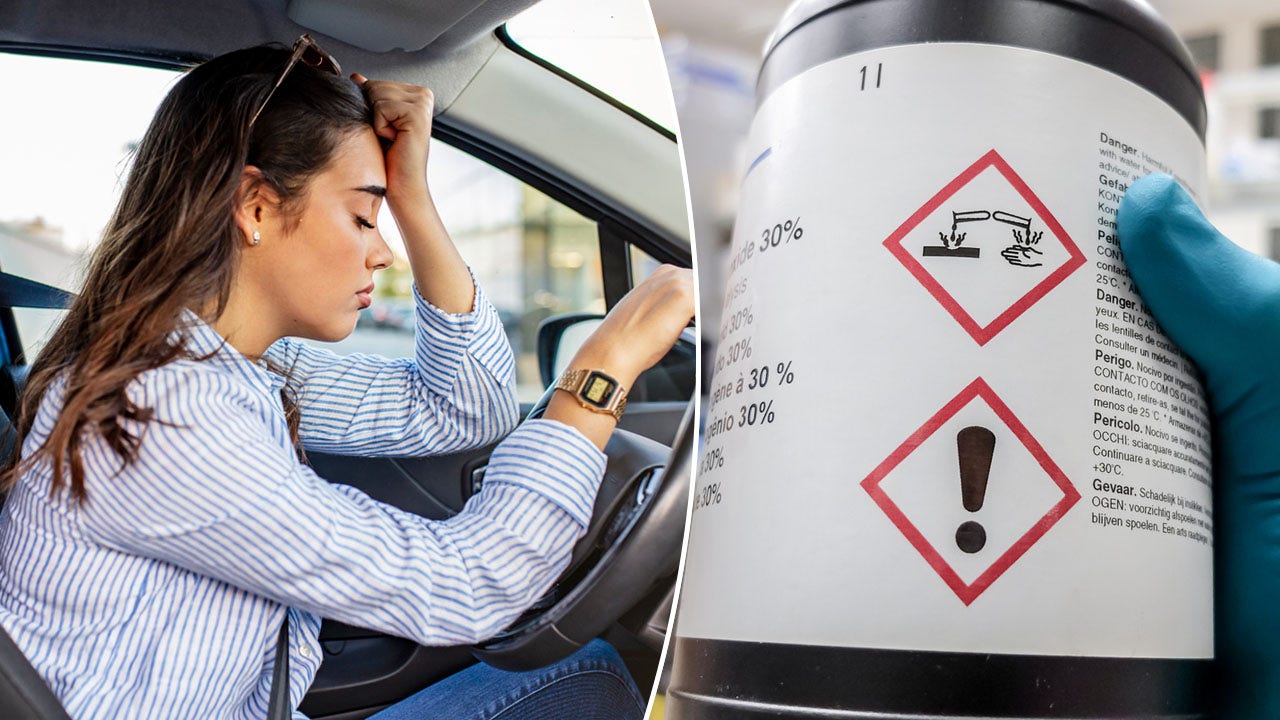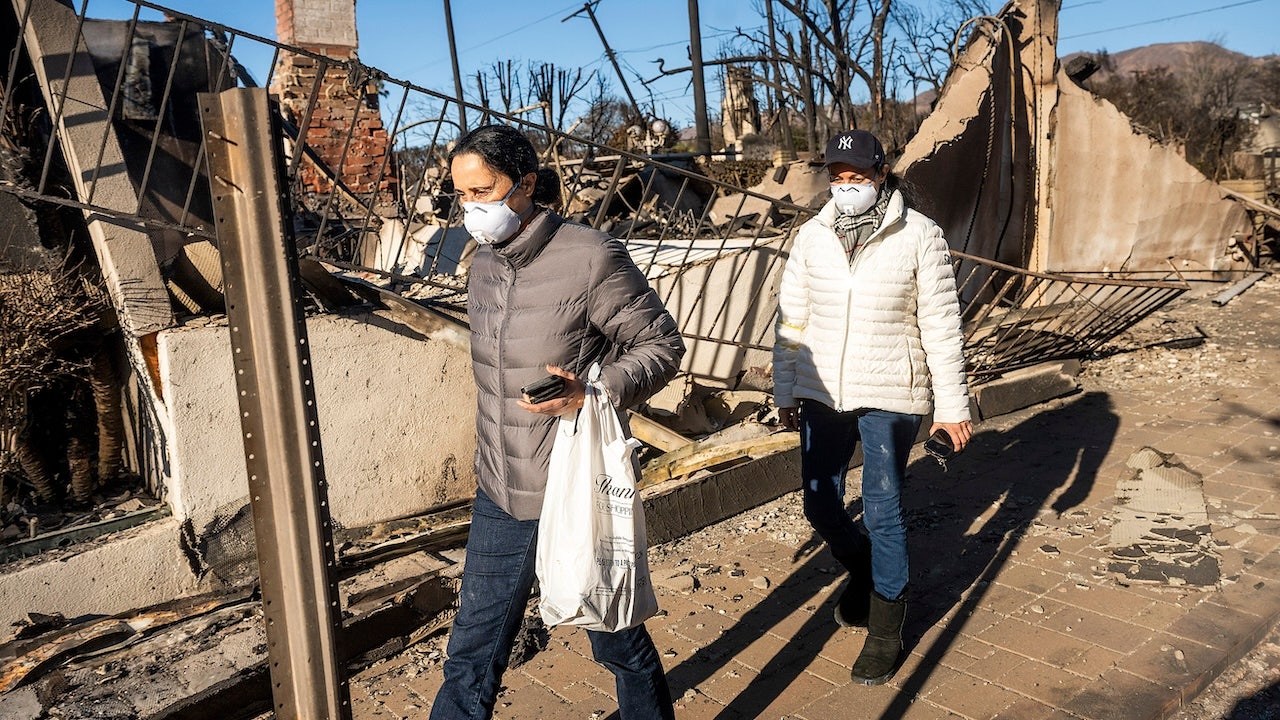Health
Could your car make you sick? Study highlights potentially cancerous toxins in vehicles

Americans may be breathing in cancer-causing chemicals while driving, recent research suggests.
A study published in the journal Environmental Science & Technology has sparked discussions about the potentially harmful toxins that could be lurking in the cabins of vehicles.
“Certainly the indoor air quality can cause health symptoms,” Dr. Ken Speath, M.D., the division chief and medical director for occupational and environmental medicine at Northwell Health on Long Island, New York, told Fox News Digital.
‘FOREVER CHEMICALS’ FOUND IN US DRINKING WATER, MAP SHOWS ‘HOT SPOTS’ OF HIGHEST LEVELS
It is important to be mindful of what you’re breathing in at home, at the office, at school and even in cars, according to Speath, who was not involved in the study.
“There can be situations where levels of harmful chemicals get high enough to potentially cause health harms,” he said.
Americans may be breathing in cancer-causing chemicals while they are driving, recent research suggests. A study published in the journal Environmental Science & Technology has sparked many discussions. (iStock)
“A car is a closed small space — so whatever is in the air is certainly going to be breathed in.”
Research reveals ‘harmful chemicals’
The peer-reviewed study looked at 101 owned vehicles in the U.S., model year 2015 or newer.
The researchers concluded that harmful flame-retardant chemicals — including those suspected of potentially causing cancer and some neurological issues — may be polluting the air inside vehicles.
DRIVING DANGERS: 9 TOP DISTRACTIONS THAT CONTRIBUTE TO ACCIDENTS, ACCORDING TO EXPERTS
“Flame retardant chemicals, which are intentionally added to vehicle interiors to meet flammability standards, are released into the cabin air from the materials to which they were applied,” lead author Rebecca Hoehn, a scientist at Duke University, told Fox News Digital.
“People in these vehicles may be exposed to these chemicals.”
Seat foam was the only material the researchers measured, Hoehn said, but other interior materials could also contain the chemicals.

The researchers concluded that harmful flame-retardant chemicals — including those suspected of potentially causing cancer and some neurological issues — may be polluting the air inside vehicles. (iStock)
“Considering the average driver spends about an hour in the car every day, this is a significant public health issue,” Hoehn warned.
“It’s particularly concerning for drivers with longer commutes, as well as child passengers, who breathe more air pound for pound than adults.”
The chemicals detected in the car cabins included a flame retardant called tris (1-chloro-isopropyl) phosphate (TCIPP), which is currently being investigated as a potential carcinogen by the U.S. National Toxicology Program.
“Considering the average driver spends about an hour in the car every day, this is a significant public health issue.”
Other flame retardants — tris (1, 3-dichloro-2-propyl) phosphate (TDCIPP) and tris (2-chloroethyl) phosphate (TCEP) — were also detected.
These are “two Californian Proposition 65 carcinogens linked to neurological and reproductive harms,” according to a press release.
Higher concentrations of the flame retardants were found during warmer weather.
“We found that the same cars, sampled in both winter and summer, had higher concentrations of flame retardants in the cabin air during the warm summer months,” Hoehn told Fox News Digital.

Flame retardants are added to vehicles to meet the National Highway Traffic Safety Administration Federal Motor Vehicle Safety Standard, which mandated their use in the 1970s. (iStock)
Flame retardants are added to vehicles to meet the National Highway Traffic Safety Administration Federal Motor Vehicle Safety Standard (FMVSS 302), which mandated their use in the 1970s, the release stated.
Flame retardants have been the “focus of concern for some time,” Speath told Fox News Digital.
More information is needed to determine the health risks these chemicals pose in humans, he said.
THESE MEDICATIONS COULD MAKE DRIVING DANGEROUS, THE FDA WARNS
“A number of these have been demonstrated in studies to have health harms in animals,” he said.
“That doesn’t necessarily mean that would be true for humans, but it raises that possibility, so we need to study these chemicals more in relation to their effects on humans.”

Higher concentrations of the flame retardants were found during warmer weather, the researchers said. (iStock)
Emanuela Taioli, M.D., PhD, the director of the Institute for Translational Epidemiology at Icahn School of Medicine at Mount Sinai in New York City, was also not part of the study, but shared her reactions.
“This is a very relevant finding, since it may prompt changes in cars’ upholstery, as well as in other parts of the car where there is foam,” she told Fox News Digital via email.
“We also want to know more about this finding and monitor whether it is replicated by other investigators.”
Other sources of toxins
Stephen Showalter, a home inspector and indoor environmental air consultant with Showalter Property Consultants in Maryland, said he typically interviews clients about their history of illness, then tests for potential sources of sickness in buildings, cars, RVs and boats.
Mold is a common culprit when it comes to health issues triggered by one’s environment, he said in an interview with Fox News Digital.
TOXIC CHEMICAL POISONING: HAVE YOU BEEN AFFECTED? HOW TO KNOW
Dr. Daniel Johns, a member of the International Society of Environmentally Acquired Illnesses and a chiropractor who practices in Annapolis, Maryland, echoed Showalter’s concerns about mold-related health issues.
Johns also cautioned that cars can be a daily source of mold exposure.
“Any water that leaks from a window, sunroof or convertible can get into the carpet and cause mold growth,” he said during an interview with Fox News Digital.

Mold is a common culprit when it comes to health issues triggered by one’s environment, according to an environmental expert. (iStock)
“Mold can start growing on a wet surface within 24 to 48 hours.”
For families with small children, spilled sippy cups could play a role when it comes to mold in cars, Johns warned.
“The water seeps into the upholstery and doesn’t get noticed or properly dried out, and the whole seat can become moldy,” he said.
“Mold can start growing on a wet surface within 24 to 48 hours.”
“Every time you sit on the seat, it releases a mold spore cloud into the car. Once that happens, you can’t clean it away. The upholstery must be removed and replaced.”
The impact of these potentially harmful pollutants can vary from one person to the next, experts told Fox News Digital.

For families with small children, spilled sippy cups could play a role when it comes to mold in cars, an expert warned. (Kids and Car Safety)
People metabolize chemicals and toxins in different ways, according to Taioli.
“Metabolism happens through enzymes that the body produces,” he said.
“Each of us has a different genetic profile that defines our metabolic capacity. As a consequence, the same amount of toxin may be metabolized better/faster by some, and worse/slower by others.”
Tips for ensuring safe interiors
While further research on car-borne chemicals is needed, experts say people can take measures to limit exposure.
“People may be able to reduce their exposure by ventilating their cars,” Hoehn advised.
“For example, rolling down the windows to let out contaminated air, or pulling in fresh air with climate control systems, should reduce concentrations.
“Ultimately, reducing the amount of flame retardants added to vehicles in the first place would provide the greatest reduction in exposure risk.”
Controlling your vehicle’s cabin temperature may also reduce exposure, she added.
“Parking in a garage or shade instead of full sun may reduce the cabin temperature and limit the extent of flame retardant release,” Hoehn said.
The researchers also called for action from regulatory agencies and vehicle manufacturers.
CLICK HERE TO SIGN UP FOR OUR HEALTH NEWSLETTER
“Ultimately, reducing the amount of flame retardants added to vehicles in the first place would provide the greatest reduction in exposure risk,” Hoehn noted.
“If flammability standards for vehicles could be revised to meet fire safety guidelines without the use of added flame retardants, risk of flame retardant exposure from personal vehicles could be greatly reduced.”

To prevent mold in a vehicle, experts recommend keeping your windows up when it rains or snows to prevent water from permeating the carpet or fabric. (iStock)
Having your car’s air quality and surfaces tested is one way to reduce the risk of exposure to allergens, toxins and chemicals, experts told Fox News Digital.
To prevent mold in a vehicle, Showalter recommends keeping your windows up when it rains or snows to prevent water from permeating the carpet or fabric.
He also cautioned about leaky air conditioners, which can foster mold growth in vehicles, and about leaving wet items in the car.
Lastly, before buying a used car, he said it is important to check the vehicle’s history to make sure it doesn’t have flood damage, which can lead to mold and other issues.
If you think you are experiencing illness due to chemical exposure in your car, home or office, it’s best to see a health care professional to discuss your symptoms.
Fox News Digital reached out to several major car companies for comment.
For more Health articles, visit www.foxnews.com/health.

Health
Childhood Vaccination Rates Were Falling Even Before the Rise of R.F.K. Jr.

After years of holding steady, American vaccination rates against once-common childhood diseases have been dropping.
Source: Centers for Disease Control and Prevention
Share of U.S. kindergartners
vaccinated against …
Nationwide, the rate of kindergartners with complete records for the measles vaccine declined from around 95 percent before the pandemic to under 93 percent last year, according to the Centers for Disease Control and Prevention. Immunization rates against polio, whooping cough and chickenpox fell similarly.
Average rates remain high, but those national figures mask far more precipitous drops in some states, counties and school districts.
In those areas, falling vaccination rates are creating new pockets of students no longer protected by herd immunity, the range considered high enough to stop an outbreak. For a community, an outbreak can be extremely disruptive. For children, measles and other once-common childhood diseases can lead to hospitalization and life-threatening complications.
Prepandemic is the average of 2017-18, 2018-19 and 2019-20 data, though not all years were available for all states. Alabama, Florida, Georgia, Iowa, Mississippi, New Hampshire, New Jersey and Delaware (in 2024) report the rate of students who have completed all required vaccines, not just the measles series. Source: Centers for Disease Control and Prevention
Change in kindergarten measles vaccination rates
Immunization rates fell in most states early in the pandemic, and continued to fall in the years that followed.
States, not the federal government, create and enforce their own vaccine mandates, but the incoming Trump administration could encourage anti-vaccine sentiment and undermine state programs. The president-elect’s nominee for health secretary, Robert F. Kennedy Jr., has spread the false theory that vaccines cause autism, among other misinformation.
But immunization rates had been falling for years before Mr. Kennedy’s recent political rise.
There are now an estimated 280,000 kindergartners without documented vaccination against measles, an increase of some 100,000 children from before the pandemic.
“These pockets are just waiting for an introduction of measles,” said Dr. William Schaffner, an infectious disease specialist at Vanderbilt University Medical Center. “It’s trouble waiting to happen.”
Why rates are falling
As the pandemic strained trust in the country’s public health system, more families of kindergartners formally opted out of routine vaccines, citing medical, philosophical or religious reasons. Others simply didn’t submit proof of a complete vaccination series, for any number of reasons, falling into noncompliance.
The shifts in exemptions mostly fall along political lines. In states that supported Mr. Trump for president in November, the number of students with official exemptions have increased on average (rising everywhere but West Virginia). Exemption rates rose in a few states that supported Vice President Kamala Harris — including Oregon, New Jersey and Minnesota — but stayed relatively flat or fell in most.
Includes medical and nonmedical exemptions. Montana was excluded due to lack of data. Wyoming is missing data for 2017-18. Delaware is missing data for 2019-20. West Virginia and Illinois are missing data for 2020-21. Source: Centers for Disease Control and Prevention.Share of kindergartners with a vaccine exemption
The pattern for noncompliance looks different: The rate of children with no vaccination record shot up in both red and blue states.
Not all children with missing records are unvaccinated. Some are in the process of getting their shots, delayed because of the pandemic, and others just never submitted documentation. Schools are supposed to bar out-of-compliance students from attending, but whether they do varies from state to state and school to school.
Montana was excluded due to lack of data. Wyoming is missing data for 2017-18. Delaware is missing data for 2019-20. West Virginia and Illinois are missing data for 2020-21. Alaska is missing data for 2018-19, 2019-20 and 2020-21. Source: Centers for Disease Control and Prevention.Share of kindergartners with no recorded vaccination, and no exemption
Surveys reveal a new and deep partisan division on this issue. In 2019, 67 percent of Democrats and Democratic leaners told Gallup that childhood immunizations were “extremely important,” compared with 52 percent of their Republican counterparts. Five years later, the enthusiasm among the Democratic grouping had fallen slightly to 63 percent. For Republicans and G.O.P. leaners it had plunged to 26 percent.
Today, 31 percent of Republicans say “vaccines are more dangerous than the diseases they were designed to protect.” Just 5 percent of Democrats say the same.
“There seems to be a divide in terms of people’s feelings about science and skepticism towards the government,” said Dr. Natasha Bagdasarian, chief medical executive for Michigan. “I think some of those divisions are becoming apparent in vaccination rates.”
Lawmakers in numerous states have tried to roll back school vaccine mandates, but most changes have been minor: Louisiana required schools to pair any mandate notifications with information about exemption laws; Idaho allowed 18-year-old students to exempt themselves; and Montana stopped collecting data from schools on immunizations.
But there are a few places where state-level policy changes, or lack thereof, appear to have had a direct effect on rates.
In Mississippi, which had long held the country’s highest kindergarten measles vaccination rate, a federal judge ordered the state to allow religious objections; the state’s vaccination rate fell. In contrast, West Virginia’s governor vetoed a bill that would have loosened school vaccine policy; the state now has the highest rate.
Rates rose in Maine and Connecticut, two states that eliminated nonmedical exemptions during the pandemic. They also rose in Alabama, according to C.D.C. data, though the state declined to comment on why.
Vulnerable pockets
Epidemiologists say that when vaccination rates slip under 90 percent for measles, outbreaks become significantly harder to contain. At some point below that, spread becomes almost inevitable if measles is introduced.
There are thousands more schools with vaccination rates below 90 percent compared with just five years ago, according to a New York Times analysis of detailed data from 22 states.
*Texas counts districts, not individual schools.
Most states publish measles, mumps and rubella (MMR) vaccine rates, but several publish only how many students complete all mandated shots. Most states exclude schools with small numbers of students. Most states publish rates for kindergartners only; for several states, however, these rates represent entire schools. New York data excludes N.Y.C. public schools. Source: state governments.
Change in share of schools with vaccination rates below 90 percent
Schools with falling rates can be found in red and blue states, in large urban districts and in small rural ones.
Measles vaccination rates dropped from 83 percent to 75 percent in Yavapai County in Arizona; from 93 percent to 78 percent in Pacific County on the coastline of Washington; from 97 percent to 93 percent in Union County, N.J., just outside New York City — places that span the political spectrum.
These numbers capture vaccination rates only for kindergartners, often partway through the school year, so they include students who may have finished their vaccine series later or will go on to finish it. And across the U.S., most students remain protected against childhood diseases.
But high rates nationally don’t help places no longer protected by herd immunity, as evidenced by recent outbreaks of childhood diseases. Measles and whooping cough cases both climbed last year; polio partly paralyzed a man in New York in 2022.
Growing anti-vaccine sentiment is only part of the public health challenge. In the Minneapolis public schools, completion rates for the measles, mumps and rubella vaccine among kindergartners dropped from around 90 percent to 75 percent. The district’s exemption rate barely moved; instead, far more students had incomplete vaccination records.
Few of those students’ families are strongly anti-vaccine, said Luisa Pessoa-Brandao, director of public health initiatives with the Minneapolis Health Department. Some are immigrants who moved into the district recently, missing either shots or records. Others missed regular doctor visits during the pandemic and got out of the habit of preventative care.
“I think we’re going to be catching up for a while,” Ms. Pessoa-Brandao said.
While vaccination rates were dropping in Minneapolis, they climbed in neighboring St. Paul Public Schools, from around 91.4 percent to around 93 percent, according to state data.
The district attributed the rise to strict new procedures started in 2021, including letters and phone calls to families in their native languages; more vaccines available on district grounds; and monthly compliance reports — an extra mile that not every district is able or willing to go.
There are still parents who opt out. But during a measles outbreak last year, a few changed their mind, said Rebecca Schmidt, the St. Paul district’s director of health and wellness.
“The fear of measles,” she said, “is sometimes greater than the ease” of getting an exemption.
Data for all 50 states
Kindergarten measles vaccination rate
Source: Centers for Disease Control and Prevention. For some years in some states, the rate represents a complete vaccine series, not just the measles vaccine.
Health
How wildfire smoke affects the body: Doctors warn of health hazards

The Los Angeles wildfires have caused devastating losses of homes and lives — and survivors may also face hidden, although still potentially very dangerous, health effects.
Wildfire smoke contains a “complex mixture” of fine particles that can pose hazards after just short-term exposure, according to the U.S. Environmental Protection Agency (EPA).
Known as PM2.5, or particulate matter, these microscopic particles and droplets are 2.5 micrometers or less in diameter.
CALIFORNIA WILDFIRES: NAVY VETERAN AND MOTHER SHARES HEART-WRENCHING EVACUATION FROM HER HOME AND COMMUNITY
“Your nose and mouth are entry points into your body,” Dr. Gustavo Ferrer, a Florida pulmonologist with extensive experience in respiratory health and air quality-related illnesses, told Fox News Digital.
“The smoke you are breathing gets caught inside your sinuses, and if you’re exposed a lot, some of that will start to irritate the lining and lead to inflammation,” a doctor warned. (AP Photo/Noah Berger) (AP Newsroom)
“The smoke you are breathing gets caught inside your sinuses, and if you’re exposed a lot, some of that will start to irritate the lining and lead to inflammation,” he warned.
“These are signs that the pollution may be overwhelming the body’s natural defenses.”
Austin Perlmutter, MD, a board-certified internal medicine physician in Seattle, noted that exposure to wildfire smoke can penetrate through the lung tissue and enter the bloodstream.
Specific health effects
People exposed to air pollution can have a number of different symptoms, including burning eyes, sore throat, cough, sinus problems, fatigue, headaches, chest pain, shortness of breath and brain fog, according to Perlmutter.
Prolonged exposure to wildfire smoke can also aggravate existing conditions such as asthma, bronchitis and other chronic respiratory diseases, Ferrer noted.
CALIFORNIA FIRES AND MENTAL HEALTH TOLL: CELEBRITIES AND THERAPISTS OFFER TIPS
“The smoke can also worsen pre-existing respiratory conditions, like asthma or emphysema,” noted Dr. Marc Siegel, clinical professor of medicine at NYU Langone Health and Fox News senior medical analyst.
“Also, not having enough oxygen can provoke a heart attack or stroke.”

People exposed to air pollution can have a number of different symptoms, including burning eyes, sore throat, cough, sinus problems, fatigue, headaches, chest pain, shortness of breath and brain fog. (AP Photo/Eric Thayer) (AP Newsroom)
Wildfire smoke has also been linked to an increased risk of a number of diseases, including heart and lung problems and brain dysfunction, Perlmutter added.
Certain groups are at a higher risk, he cautioned, including people with underlying heart and lung diseases or other existing chronic diseases, as well as infants, young children and older adults.
“The smoke can worsen pre-existing respiratory conditions, like asthma or emphysema.”
There are also mental health effects, according to Siegel.
A 10-year study in Nature Mental Health showed a “significant mental health impact” on Californians exposed to wildfires, the doctor pointed out.
“People may feel anxiety over being displaced or fear of losing their homes,” Siegel said. “This may lead to them being unable to sleep.”
There is also the increased danger of falls and other injuries from being in damaged areas where fire-related devastation occurred, he added.
6 tips to protect health amid wildfires
Experts shared the following steps people can take to help reduce the risk of wildfire health effects.
1. Practice nasal hygiene
Keeping your nasal passages open and clean is essential, Ferrer emphasized.
“Washing daily, or up to two times a day or regularly, using a saline nasal spray can help clean the filter that’s inside your nose so it’s as effective as possible,” he told Fox News Digital.

During periods of high smoke levels, it’s best to limit time outdoors and keep windows and doors closed, experts agreed. (Richard Vogel)
People can use a pre-made saline solution or make their own at home with distilled water and salt, he said.
2. Stay indoors and optimize indoor air
During periods of high smoke levels, it’s best to limit time outdoors and keep windows and doors closed, according to Ferrer.
Using HEPA filters can also help to improve air quality, Shah noted.
“Invest in air purifiers with HEPA filters to trap fine particulate matter (PM2.5) from wildfire smoke,” he suggested.
Shah also recommends using weather stripping where needed and changing HVAC filters at a higher frequency.

During the first few months of cleanup, excess chemicals and particulates that are released can significantly worsen air quality. (iStock)
People may also want to minimize “indoor air pollution,” Perlmutter added.
“Don’t light candles, fires or incense and don’t smoke indoors,” he advised. “If you cook, ventilate using a hood if you have one.”
3. Consider leaving the area temporarily
During the first few months of cleanup, excess chemicals and particulates that are released can significantly worsen air quality, warned Dr. Darshan Shah, MD, a board-certified surgeon and founder and CEO of Next Health in California.
CLICK HERE TO SIGN UP FOR OUR HEALTH NEWSLETTER
“Consider relocating temporarily to a safer area until conditions improve,” he recommended.
4. Wear a mask
When venturing outside, experts recommend wearing a well-fitting N95 respirator mask to filter out smoke particles.

When venturing outside, experts recommend wearing a well-fitting N95 respirator mask to filter out smoke particles. (AP Newsroom)
“Cloth masks, dust masks and other lower quality masks likely won’t provide much protection,” Perlmutter said.
5. Monitor air quality
Experts recommend regularly checking the AQI (Air Quality Index).
“Use apps or websites (like AirNow) to monitor air quality and avoid outdoor activities when AQI is unhealthy,” Shah said.
For more Health articles, visit www.foxnews.com/health
6. Do not tour burned areas
“Avoid visiting recently burned areas, as they pose a high risk of exposure to harmful chemicals and smoldering smoke, which can severely impact respiratory and overall health,” Shah advised.
Health
How The Great British Bake Off Host Alison Hammond Lost 150 Lbs Naturally

Sign Up
Create a free account to access exclusive content, play games, solve puzzles, test your pop-culture knowledge and receive special offers.
Already have an account? Login
Use left and right arrow keys to navigate between menu items.
Use escape to exit the menu.
-

 Politics1 week ago
Politics1 week agoWho Are the Recipients of the Presidential Medal of Freedom?
-

 Health1 week ago
Health1 week agoOzempic ‘microdosing’ is the new weight-loss trend: Should you try it?
-
/cdn.vox-cdn.com/uploads/chorus_asset/file/25822586/STK169_ZUCKERBERG_MAGA_STKS491_CVIRGINIA_A.jpg)
/cdn.vox-cdn.com/uploads/chorus_asset/file/25822586/STK169_ZUCKERBERG_MAGA_STKS491_CVIRGINIA_A.jpg) Technology4 days ago
Technology4 days agoMeta is highlighting a splintering global approach to online speech
-

 News1 week ago
News1 week agoSeeking to heal the country, Jimmy Carter pardoned men who evaded the Vietnam War draft
-

 Science2 days ago
Science2 days agoMetro will offer free rides in L.A. through Sunday due to fires
-

 News1 week ago
News1 week agoTrump Has Reeled in More Than $200 Million Since Election Day
-

 Movie Reviews6 days ago
Movie Reviews6 days ago‘How to Make Millions Before Grandma Dies’ Review: Thai Oscar Entry Is a Disarmingly Sentimental Tear-Jerker
-
/cdn.vox-cdn.com/uploads/chorus_asset/file/25821992/videoframe_720397.png)
/cdn.vox-cdn.com/uploads/chorus_asset/file/25821992/videoframe_720397.png) Technology6 days ago
Technology6 days agoLas Vegas police release ChatGPT logs from the suspect in the Cybertruck explosion














